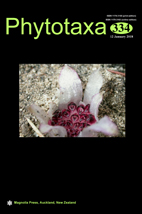Abstract
Living material of a marine red alga consisting of a prostrate basal system and small erect blades was isolated from laboratory-incubated substratum collected in a sea cave at 7 m depth on Easter Island in the Southeast Pacific. The alga in culture was morphologically identified as Apoglossum gregarium (E.Y. Dawson) M.J. Wynne. Molecular analyses (rbcL, LSU, COI) revealed that this alga was not closely related to Apoglossum ruscifolium (Turner) J. Agardh, the generitype. It also was genetically and morphologically distinct from Paraglossum and other genera in the Delesseriaceae. Therefore, it is proposed that the genus Phrix J.G. Stewart be reinstated. Because the taxonomic synonym Membranoptera spatulata E.Y. Dawson has priority over Hypoglossum gregarium E.Y. Dawson, the binomial Phrix spatulata (E.Y. Dawson) comb. nov. is effected as the name for the sole species currently recognized in this genus of the Delesseriaceae (Rhodophyta). This is a new record of the species from Chile. The basal system in culture developed from numerous coalescent uniseriate filaments from which the blades arose and showed this isolate to be a male with spermatangial sori.

